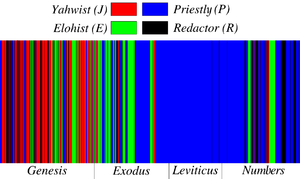
This post continues from my post some weeks ago in which I covered primarily Philippe Wajdenbaum’s account of the rise of the Documentary Hypothesis. At that time in one of the comments I explained I had paused to take stock of how best to address the challenge that has arisen against the Documentary Hypothesis. This is a study I undertook some years ago and so thoroughly enjoyed that it is easy for me to cover way too much detail. Maybe I will have to return to address some of the specifics in separate posts later. Once this is out of the way I would like to post another explaining how political anthropology offers a cogent explanation for the character of the biblical books as Hellenistic productions.
First, to recap the Documentary Hypothesis. This is the idea that the Old Testament was essentially a result of four separate sources that were originally written over a span of some centuries:
- a Jahwist/Yahwist (J) written in the southern kingdom of Judah around the time of Solomon – 10th century bce / later shifted to the Babylonian Exile period:
- Gerhard von Rad in 1944 “considers the time of Solomonic enlightenment to contain all the prerequisites for literary production, including history writing. It was first of all a time of political stability and economic prosperity. On top of this came the need of a new state to provide a history of its past. Finally the creative impetus following in the wake of the establishment of an Israelite state created this new literature.”
- Subsequent scholarship revised this, arguing that “External circumstances were thought to provide the most likely background for this kind of literature.” (pp. 158-9 of The Israelites in History and Tradition, Niels Peter Lemche)
- an Elohist (E) composed in the northern kingdom of Israel – 9th or 8th century bce
- a Deuteronomist (D) in the southern kingdom of Judah at time of Josiah – late 7th century bce
- a Priestly source (P) during the Babylonian Exile – 6th century bce
The dating of the sources is central to the hypothesis:
Essential to the history of scholarship expressed in Wellhausen’s synthesis [the DH is the result of W’s synthesis of two generations of OT historical-critical scholarship] was that these four discrete sources of the pentateuch were to be understood as literary documents created at the time of their written composition, and hence as compositions reflecting the understanding and knowledge of their authors and their world. (p. 2 of Early History of the Israelite People from the Written & Archaeological Sources, by Thomas L. Thompson.)
This meant, for example, that the Pentateuch was not a reliable source for the events it narrates, such as the Patriarchal period and Exodus.
But in recent decades biblical scholars are not so united in their acceptance of this explanation for the Bible or “Old Testament” portion of it.
Basically, the old consensus that had developed around the Documentary Hypothesis has gone, though there is nothing to take its place (Rendtorff 1997; Whybray 1987). Some still accept the Documentary Hypothesis in much its original form, but many accept only aspects of it or at least put a question mark by it. There has also been much debate around the J source (Rendtorff 1997: 53-5) and the P source (Grabbe 1997). It seems clear that the Pentateuch was put together in the Persian period (Grabbe 2004:331-43; 2006). (p. 44 of Ancient Israel: What Do We Know and How Do We Know It? by Lester L. Grabbe)
So where have the cracks appeared? Continue reading “Who wrote the Bible? (2) Challenging the Documentary Hypothesis”
